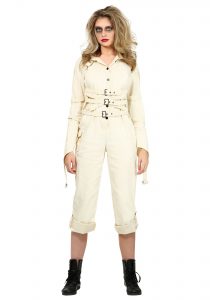
Why we need to ditch the straitjacket costumes and ‘asylum’-themed haunted houses
By Bex Peterson, Editor-in-Chief
I really loved Fright Nights at Playland the two times that I went. I loved the spooky atmosphere, the thrill of going on some of my favourite rides at night, and the genuinely entertaining and well-designed haunted houses. I loved it all… except one distinctly uncomfortable corner of the park, and the one house I refused to step inside: The “Asylum”.
It’s your classic “terrifying mental hospital” fare—cackling doctors, nurses wielding comically large needles, patients screaming and thrashing about in straitjackets. Spooky, right?
The concept of the asylum seems like a staple of the campy Halloween atmosphere. Many horror movies have an element of the asylum baked in, and plenty of Halloween stores sell madhouse-themed props and costumes (seriously, Party City has a whole section of their website dedicated to it). For most people, I’m sure, it’s a harmless good time. Some might even shake their heads in a removed kind of sympathy; “Man, it sure used to suck for crazy people back in the day, huh? Glad it’s not like this anymore.”
I can see about a million problems with all this, but I’ll try to boil it down to two main ones: Making already vulnerable people out to be monsters is never a good idea and exploiting the real-life problems of abuse in mental health care facilities for fun and profit is gross.
You might not think that turning mental illness into campy horror fun has any real-world impact. After all, you might argue, tons of violent killers are like this, so the horror is just reflecting real life! The problem here is that it’s contributing to a stereotype that is factually untrue. According to several statistics, not only are people with mental health problems just as unlikely to commit violent crimes as neurotypical people, but we’re over 10 times more likely to be victims of violent crime ourselves.
I say “we” and “our” because I live with mental illness, and I can tell you that this dehumanization has a personal impact on me. When I avoided the “Asylum” part of the Fright Nights experience, it wasn’t because I thought it was morally wrong at the time—it’s because it was personally painful to see parts of my experience being portrayed as campy horror. It kept me from talking about the more alienating aspects of my mental illness for a long time because I was so afraid of being seen as a monster.
Even when mentally ill people are portrayed as the tragic victims of evil doctors for horror purposes, I get uncomfortable because abuse in the mental health care community is a genuine problem. As a queer person, I’ve experienced my own fair share of “horror” from mental health care professionals, including one psychologist who implied that he could “fix” my sexuality with his treatment program. There are still plenty of places which see anything other than heterosexuality as a sign of insanity, and shock therapy is still encouraged as a cure—forgive me if I don’t laugh in spooky delight when I see this used as a jump scare in a haunted house.
If you do go to Fright Night this year, I know I can’t make you boycott the Asylum attraction. I only ask that you try to imagine if those actors in straitjackets were all trying to look and sound like you. Would it still be fun? Or would it be terrifying for an entirely different reason?


